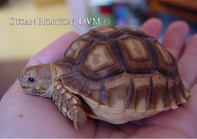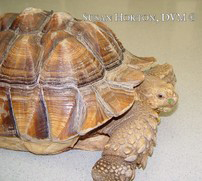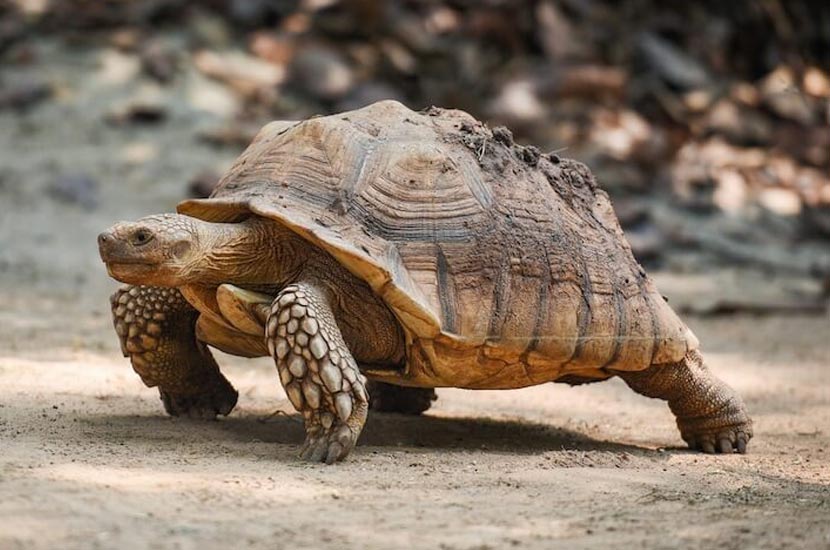Erica Mede, CVT
Photos and edited by Susan Horton, DVM
Natural History
 Sulcatas are found along the southern edge of the Sahara in Africa and created large burrows and tunnels during the dry season to escape the heat and dry conditions. This species of tortoise was first imported into the United States in 1980 and has become a prolific captive breeding species! Sadly, there is a decreasing population in the wild due to habitat destruction and human influence but in captivity there is an over population. The Sulcata is listed as a CITES Appendix 2 species which means that captive bred tortoises can be sold and traded but wild caught tortoises are strictly protected.
Sulcatas are found along the southern edge of the Sahara in Africa and created large burrows and tunnels during the dry season to escape the heat and dry conditions. This species of tortoise was first imported into the United States in 1980 and has become a prolific captive breeding species! Sadly, there is a decreasing population in the wild due to habitat destruction and human influence but in captivity there is an over population. The Sulcata is listed as a CITES Appendix 2 species which means that captive bred tortoises can be sold and traded but wild caught tortoises are strictly protected.
Description
The record weight for a large male Sulcata was over 230 pounds and had a carapace over 2.5 feet long. As with all animals, Sulcata tortoises grow at individual rates but all hatchlings and young tortoises grow fast. The Sulcata is the fastest growing tortoise, especially in the first five years of life. In optimal climates this species can easily reach 100 pounds within 15 years. However, in the Midwestern United States and along the northern East coast of the United States , most stay around 30-50 lbs with few individuals becoming larger than that. Despite the different climates these animals are kept in one thing proves the same across the board, Sulcatas are a hardy species. Most Sulcatas in captivity have a longevity of 30-50 years and up to 120 years in the wild.
The carapace of Sulcatas is wider than it is tall. In the wild, most individuals have a light tan carapace but dark brown is a common color especially in colder climates. Sulcatas are called “spur thighed” due to the large conical projections on the back of the rear legs that act as another defense against predation. Below the head there is a gular spike which is an extension of the plastron and used to flip rivals during courtship.
The Sulcata tortoise has three defense mechanisms. The first is to retract the limbs under the shell. The second is to hiss loudly. If the tortoise is picked up it will urinate copiously which is the third defense mechanism.
Sexing
The male Sulcata tortoise has a longer, thicker tail and the anal scute of the plastron (right by the tail) is wider even at a young age. The female has a shorter tail than the male. Males have a concave plastron for aiding with copulation and also have larger gular scutes under the head for flipping rivals.
Enclosure
Sulcata tortoises are diurnal often retreating to shelter once dark. Logs and bushes make excellent shelters as do turned over cement mixing trays with a door cut out, wooden hide boxes, etc. All enclosures should be tortoise proof. Solid wood trim or ram resistant bricks are essential for indoor and outdoor enclosures larger than aquarium tanks. As the tortoise grows, a custom built wooden enclosure will be required.
Hatchlings can be kept in a 10 gallon tank and increased in size from there. Remember, as your tortoise grows he will need a custom enclosure! This is not a species that can be kept in aquariums all their lives. Many people think they will not outgrow their cage like goldfish. In both instances, of the tortoise and the goldfish, this is false and they will continue to grow despite cramped conditions. As hatchlings grow they will need a two foot by two foot cage up to a four foot by eight foot cage. A turtle table is an excellent set-up for hatchlings and juveniles and many plans for these enclosures can be found on the internet.
Indoor enclosures should be spacious and heated. Adults will require brick, concrete, and armored glass. Some people use heated basements or attics where the whole or at least most of the space can be dedicated to the tortoise enclosure. The enclosure space should be at least four times the carapace length. If two animals are being kept together, double the size of the enclosure and add an additional 10% for each animal after three tortoises. A trio of similar sized Sulcatas can be housed together in an enclosure that measures 16 feet by 16 feet.
Outdoor enclosures should be large, sunny, and protected from the wind and predators. An adjoining spacious and heatable building is required if the tortoise is to remain outdoors year round. Remember, the driest season in the mid-western United States is like the rainy season in its natural African habitat. Some people use a green house to house their tortoise. Leopard tortoises can learn to use a rubber flap dog door. The enclosure should be free of large trees or high shrubs that will create large areas of shade. Check with your local authorities before constructing any outdoor pen as permits may be required. If the temperature is constantly below 60°F degrees bring the tortoise inside. The fence to any out door area should be at least 12-24 inches into the ground and at least 18-24 inches in height. A word of caution, escape attempts never cease and these tortoises will climb wire mesh fences or will tunnel under. The tunnels can be up to 25 times the length of the carapace!
Substrate
 Substrate for young tortoises should be rather simple and easily cleaned. The most recommended substrate for juveniles is reptile carpet or butcher paper with hay on top of it. Rabbit pellets are frequently used in the pet trade for hatchlings to juveniles but recently has been found to cause deformities in these fast growers due to improper positioning of limbs in hatchlings. Ideally adults should be housed with hay substrate for their outdoor and indoor enclosures as well. Daily spot cleaning is required with a complete substrate change every 2-3 weeks. Gravid females (females with eggs) may require a dig box of dirt and sand to lay their eggs and adults in general love to dig. Sulcatas are one of the three true tunnel digging tortoise species. Rocks, tree trunks, boulders, and roots create obstacles and mental stimulation.
Substrate for young tortoises should be rather simple and easily cleaned. The most recommended substrate for juveniles is reptile carpet or butcher paper with hay on top of it. Rabbit pellets are frequently used in the pet trade for hatchlings to juveniles but recently has been found to cause deformities in these fast growers due to improper positioning of limbs in hatchlings. Ideally adults should be housed with hay substrate for their outdoor and indoor enclosures as well. Daily spot cleaning is required with a complete substrate change every 2-3 weeks. Gravid females (females with eggs) may require a dig box of dirt and sand to lay their eggs and adults in general love to dig. Sulcatas are one of the three true tunnel digging tortoise species. Rocks, tree trunks, boulders, and roots create obstacles and mental stimulation.
Lighting
The lighting in the cage should replicate the lighting of the wild. There should be a high level of illumination and heat. Adults with large pens will require several UVB bulbs. All tortoises should be exposed to UVB light or natural sunlight for at least 8 hours a day and total illumination for 10-14 hours.
Temperature and Humidity
Relative humidity of 40-60% is ideal during the day and 70-80% at night which can be accomplished by misting the substrate at night. During the day the temperatures should be in the 80’s with a basking spot around 95 degrees. At night the temperatures should not drop below 72 degrees. A consistent heating regiment can be maintained using basking bulbs, ceramic heat emitters, mercury bulbs (when the enclosures are larger), and under tank heaters. In the cases of large adults, pig heat blankets may need to be used.
Feeding (See our feeding Sulcatas handout)
Diet is the most important aspect of tortoise care and sadly, one of the most neglected and misunderstood. Feeding foods to high in fat and protein will cause accelerated growth, shell deformities, and other health problems that will severely shorten the life of your pet. Never feed bread, cookies, oats, pasta, rice, or cat/dog food! These are harmful to your pet’s nutrition and health!
The primary portion (75-80%) of the Sulcata tortoise diet should be grass and hay high in fiber. Grasses (not rye grass), weeds, leaves, and flowers are essential to good health. Fiber deficiency leads to metabolic bone disease and diarrhea while also making them susceptible to parasites. A pasture of grass, dandelion, herbs, and clover outdoors is the best option for these animals. If a pasture is restricted due to size, fresh cut works as well. Orchard grass/hay, timothy grass/hay, and Bermuda grass/hay are excellent especially during those winter months when the tortoise may be housed inside. Sulcata tortoises should be given as much opportunity to graze outdoors as possible.
Vegetables and fruit should be fed out in smaller portions. Vegetables should make up around 20-25% of the diet. Too much fruit will cause diarrhea and colic. Chopped salads are an excellent way to ensure a tortoise does not pick out their favorite foods only. Vegetables for human consumption are high in protein and fruits are high in sugar both of which in excess are harmful to your tortoise. Moderation is key in this case. Dark leafy greens, endive, and cactus pads are favorites as well as pumpkin! For picky eaters, red vegetables and sweet foods tempt even the most reluctant eaters.
Calcium supplements should be given to adult tortoises two times a week. Actively reproductive females should be given the calcium every day while gravid until they lay their eggs. Calcium supplements should not have phosphorous in it. Juveniles should be given calcium four times a week and vitamin-mineral supplements once a week until growing slows. Hatchlings are given vitamin-mineral supplements once a week and calcium daily.
Clean, fresh water should always be available to Leopard tortoises. These tortoises have an ability to store substantial amounts of fluid and also to discharge the substantial amounts of fluid as a defense mechanism as well. Soaking weekly is recommended. Water should be provided in a shallow water hole, pan or bowl depending on the enclosure.
References and Sources
Sulcata and Leopard Tortoises (Complete Herp Care), E.J. Pirog
Turtles of the World (Volumes 3), Holger Vetter
Leopard and African Spurred Tortoise: Stigmochelys pardalis and Centrochelys sulcata, Holger Vetter
The Care and Breeding of the African Spurred Tortoise Geochelone sulcata, Richard Wilson
African Spurred Tortoise Geochelone Sulcata In Captivity, Russ Gurley
If you have any questions, please feel free to call us at (502) 241-4117.

